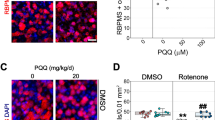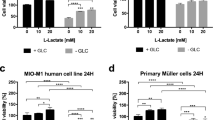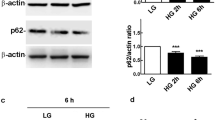Abstract
In this study, we analyzed how distinct glycolysis inhibitors influenced the redox status of retinal cells, used as a neuronal model. Three different approaches were used to inhibit glycolysis: the cells were submitted to iodoacetic acid (IAA), an inhibitor of glyceraldehyde 3-phosphate dehydrogenase, to 2-deoxy-glucose (DG) in glucose-free medium, which was used as a substitute of glucose, or in the absence of glucose. The redox status of the cells was evaluated by determining the reduction of MTT (3-(4,5-dimethylthiazol-2-yl)-2,5-diphenyl tetrazolium bromide). By the analysis of dose-response curves of MTT reduction, IAA showed values of IC50 = 7.02 × 10−5 M, whereas DG showed values of IC50 = 7.42 × 10−4 M. Upon 30 min-incubation, glucose deprivation, per se, did not significantly affect MTT reduction. We also evaluated the reduction of MTT as an indicator of cell injury by exposing the cells to 100 μM glutamate during the decrement of glycolysis function. In the presence of glutamate, for 2 h, there was a decrease in MTT reduction, which was potentiated in the presence of DG (10-20% decrease), in the presence of IAA (about 30% decrease) or in glucose-free medium (about 30% decrease). Major changes observed by the MTT assay, upon exposure to glutamate, indicative of changes in the redox status of retinal cells, were concomitant with variations in intracellular ATP. Under glucose deprivation, endogenous ATP decreased significantly from 38.9 ± 4.4 to 13.3 ± 0.7 nmol/mg protein after exposure to 100 μM glutamate. The results support a different vulnerability of retinal cells after being exposed to distinct forms of glycolysis inhibition.
Similar content being viewed by others
REFERENCES
Cunha-Vaz, J. G., Leite, E., Castro Sousa, J.P., and Faria de Abreu, J. R. 1993. Blood-retinal barrier permeability and its relation to progression of diabetic retinopathy. A four year follow-up study. Graefe's Arch. Clin. Exp. Ophthalmol. 231:141–145.
Weiss, H. 1972. The carbohydrate reserve in the vitreous body and retina of the rabbit's eye during and after pressure ischaemia and insulin hypoglycaemia. Ophthalmol. Res. 1:360–371.
Lipton, P., and Robacker, K. 1983. Glycolysis and brain function: [K+]o stimulation of protein synthesis and K+ uptake require glycolysis. Federation Proc. 42:2875–2880.
Kauppinen, R. A., and Nicholls, D. G. 1986. Failure to maintain glycolysis in anoxic nerve terminals. J. Neurochem. 47:1864–1869.
Longuemare, M. C., Hill, M. P., and Swanson, R. A. 1994. Glycolysis can prevent nonsynaptic excitatory amino acid release during hypoxia. NeuroReport 5:1789–1792.
Zeevalk, G. D., and Nicklas, W. J. 1990. Chemically induced hypoglycemia and anoxia: relationship to glutamate receptor-mediated toxicity in retina. J. Pharmacol. Exp. Therap. 253:1285–1292.
Rego, A. C., Santos, M. S., and Oliveira, C. R. 1997. Adenosine triphosphate degradation products upon oxidative stress and metabolic dysfunction situations. J. Neurochem. 69:1228–1235.
Rego, A. C., Santos, M. S., and Oliveira, C. R. 1996. Oxidative stress, hypoxia, and ischemia-like conditions increase the release of endogenous amino acids by distinct mechanisms in cultured retinal cells. J. Neurochem. 66:2506–2516.
Obrenovitch, T. P., and Urenjak, J. 1997. Altered glutamatergic transmission in neurological disorders: from high extracellular glutamate to excessive synaptic efficacy. Prog. Neurobiol. 51:39–87.
Mosmann, T. 1983. Rapid colorimetric assay for cellular growth and survival: application to proliferation and cytotoxicity assays. J. Immunol. Meth. 65:55–63.
Slater, T. F., Sawyer, B., and Sträuli, U. 1963. Studies on succinate-tetrazolium reductase system. III. Points of coupling of four different tetrazolium salts. Biochim. Biophys. Acta 77:383–393.
Keller, J. N., Mark, R. J., Bruce, A. J., Blanc, E., Rothstein, J. D., Uchida, K., Waeg, G., and Mattson, M. P. 1997. 4-Hydroxynonenal, an aldehydic product of membrane lipid peroxidation, impairs glutamate transport and mitochondrial function in synaptosomes. Neuroscience 80:685–696.
Keller, J. N., Pang, Z., Geddes, J. W., Begley, J. G., Germeyer, A., Waeg, G., and Mattson, M. P. 1997. Impairment of glucose and glutamate transport and induction of mitochondrial oxidative stress and dysfunction in synaptosomes by amyloid β-peptide: role of the lipid peroxidation product 4-hydroxynonenal. J. Neurochem. 69:273–284.
Musser, D. A., and Oseroff, A. R. 1994. The use of tetrazolium salts to determine sites of damage to the mitochondrial electron transport chain in intact cells following in vitro photodynamic therapy with photofrin II. Photochem. Photobiol. 59:621–626.
Agostinho, P., Duarte, C. B., Carvalho, A. P., and Oliveira, C. R. 1994. Effect of oxidative stress on the release of [3H]GABA in cultured chick retinal cells. Brain Res. 655:213–221.
Huba, R., and Hofmann, H. D. 1990. Identification of GABAergic amacrine cell-like neurons developing in retina monolayer cultures. Neurosci. Lett. 117:37–42.
Agostinho, P., Duarte, C. B., and Oliveira, C. R. 1996. Activity of ionotropic glutamate receptors in retinal cells: Effect of ascor-bate/Fe2-induced oxidative stress. J. Neurochem. 67:1153–1163.
Sedmak, J. J., and Grossberg, S. E. 1977. A rapid sensitive and versatile assay for protein using Coomassie Brilliant Blue G250. Anal. Biochem. 79:544–552.
Stocchi, V., Cucchiarini, L., Chiarantini, L., Palma, P., and Crescentini, G. 1985. Simultaneous extraction and reverse-phase high-performance liquid chromatographic determination of adenine and pyridine nucleotides in human red blood cells. Anal. Biochem. 146:118–124.
Kaneko, I., Yamada, N., Sakuraba, Y., Kamenosono, M., and Tutumi, S. 1995. Suppression of mitochondrial succinate dehydrogenase, a primary target of β-amyloid, and its derivative racemized at Ser residue. J. Neurochem. 65:2585–2593.
Shearman, M. S., Hawtin, S. R., and Tailor, V. J. 1995. The intracellular component of cellular 3-(4,5-dimethylthiazol-2-yl)-2,5-diphenyltetrazolium bromide (MTT) reduction is specifically inhibited by β-amyloid peptides. J. Neurochem. 65:218–227.
Dhanjal, P., and Fry, J. R. 1997. Determinants of MTT reduction in rat hepatocytes. Biomarkers 2:111–116.
Patel, A. J., Gunasekera, S., Jen, A., and de Silva, H. A. R. 1996. β-Amyloid-mediated inhibition of redox activity (MTT reduction) is not an indicator of astroglial degeneration. NeuroReport 7:2026–2030.
Liu, Y., Peterson, D. A., Kimura, H., and Schubert, D. 1997. Mechanism of cellular 3-(4,5-dimethylthiazol-2-yl)-2,5-diphenyltetrazolium bromide (MTT) reduction. J. Neurochem. 69:581–593.
Burdon, R. H., Gill, V., and Rice-Evens, C. 1993. Reduction of a tetrazolium salt and superoxide generation in human tumor cells (HeLa). Free Rad. Res. Commun. 18:369–380.
Altman, F. P. 1976. Tetrazolium salts and formazans. Prog. Histochem. Cytochem. 9:1–56.
Milusheva, E. A., Dóda, M., Baranyi, M., and Vizi, E. S. 1996. Effect of hypoxia and glucose deprivation on ATP level, adenylate energy charge and [Ca2+]o-dependent and independent release of [3H]dopamine in rat striatal slices. Neurochem. Int. 28:501–507.
Cheng, B., McMahon, D. G., and Mattson, M. P. 1993. Modulation of calcium current, intracellular calcium levels and cell survival by glucose deprivation and growth factors in hippocampal neurons. Brain Res. 607:275–285.
Bright, R. T., Salvaterra, C. G., Rubin, L. J., and Yuan, X.-J. 1995. Inhibition of glycolysis by 2-DG increases [Ca2+]i in pulmonary arterial smooth muscle cells. Am. J. Physiol. 269:L203–L208.
Romano, C., Price, M. T., and Olney, J. W. 1995. Delayed excitotoxic neurodegeneration induced by excitatory amino acid agonists in isolated retina. J. Neurochem. 65:59–67.
Gemba, T., Oshima, T., and Ninomiya, M. 1994. Glutamate efflux via the reversal of the sodium-dependent glutamate transporter caused by glycolytic inhibition in rat cultured astrocytes. Neuroscience 63:789–795.
Okazaki, S., Nishida, Y., Kawai, H., and Saito, S. 1996. Acute neurotoxicity of L-glutamate induced by impairment of the glutamate uptake system. Neurochem. Res. 21:1201–1207.
Velasco, I., Tapia, R., and Massieu, L. 1996. Inhibition of glutamate uptake induces progressive accumulation of extracellular glutamate and neuronal damage in rat cortical cultures. J. Neurosci. Res. 44:551–561.
Williams, R. J., Murphy, N., Glowinski, J., and Prémont, J. 1995. Glucose regulates glutamate-evoked arachidonic acid release from cultured striatal neurons. J. Neurochem. 65:241–249.
Williams, R. J., Maus, M., Stella, N., Glowinski, J., and Prémont, J. 1996. Reduced glucose metabolism enhances the glutamate-evoked release of arachidonic acid from striatal neurons. Neuroscience 74:461–468.
Author information
Authors and Affiliations
Rights and permissions
About this article
Cite this article
Rego, A.C., Areias, F.M., Santos, M.S. et al. Distinct Glycolysis Inhibitors Determine Retinal Cell Sensitivity to Glutamate-Mediated Injury. Neurochem Res 24, 351–358 (1999). https://doi.org/10.1023/A:1020977331372
Issue Date:
DOI: https://doi.org/10.1023/A:1020977331372




